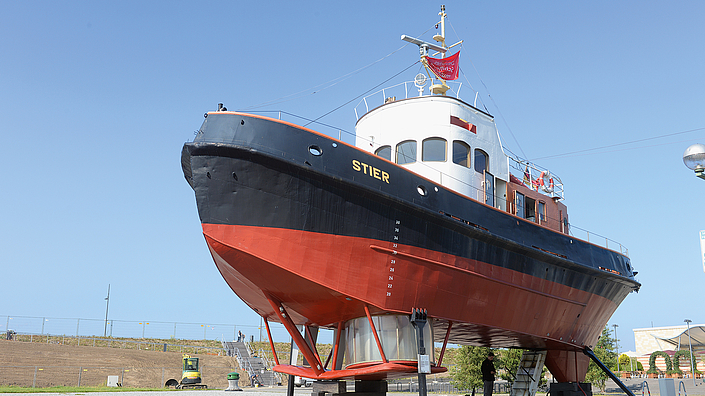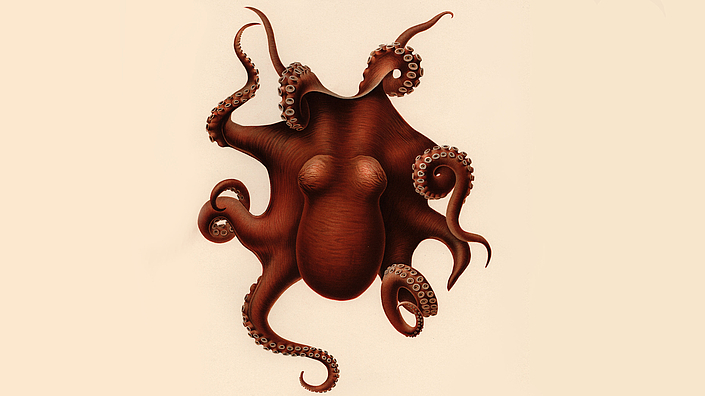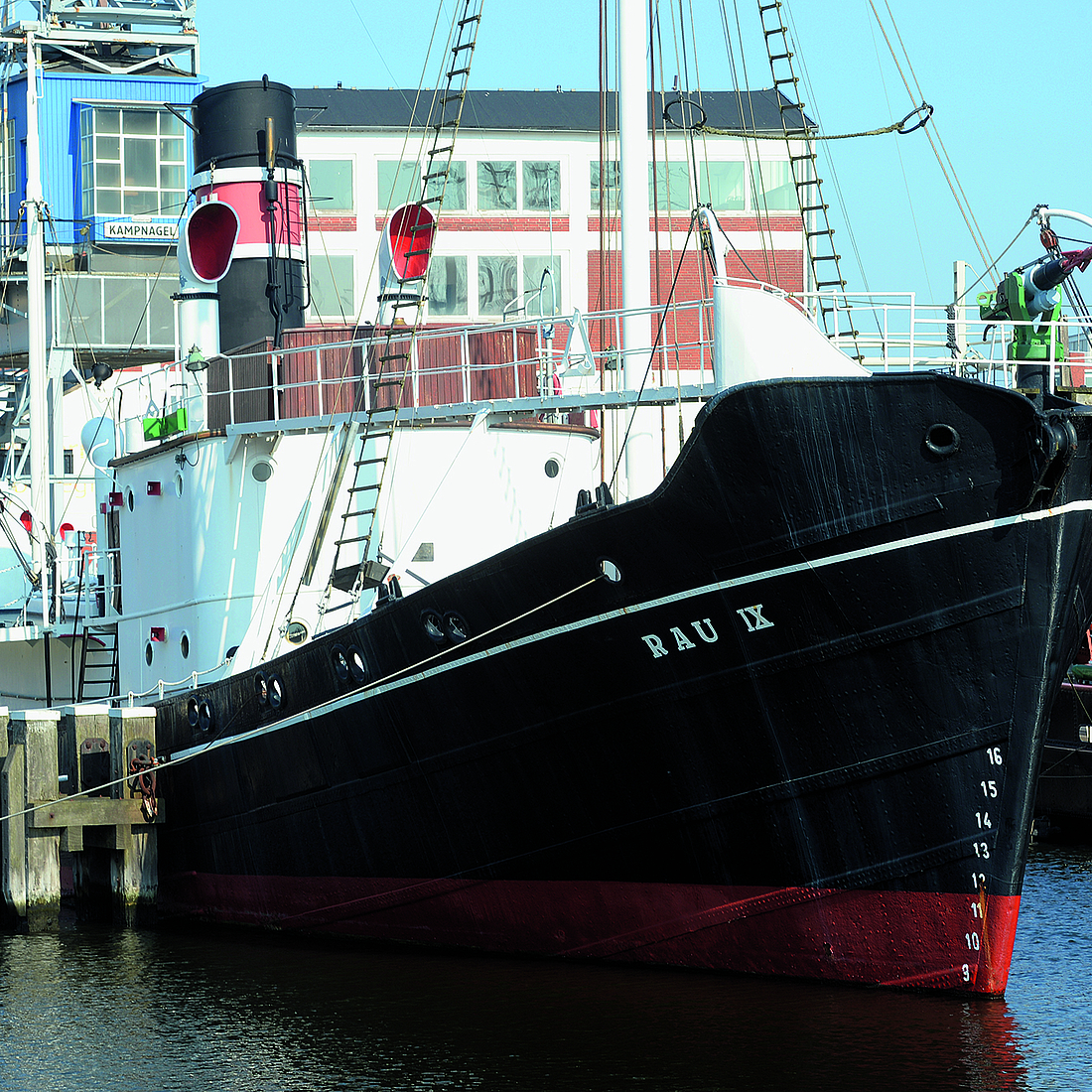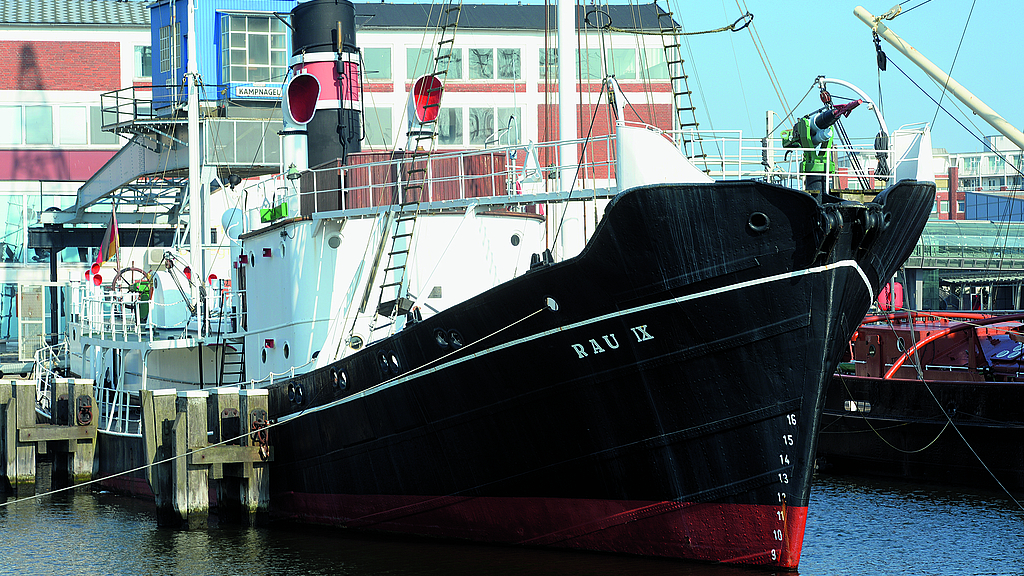The RAU IX – evidence of past whaling
Explore the eventful history of RAU IX. Go on board to get an idea of the working conditions and technical developments, but also to understand the overexploitation of marine mammals.
The Rau IX, built in 1939, lies in our museum harbour as a testimony to Germany's efforts in industrial whaling. She was the ninth in a series of ships built between 1937 and 1939 for the Walter Rau whaling fleet at the Seebeck shipyard in Wesermünde (now Bremerhaven). Walter Rau was a margarine producer with good contacts to the political elite in National Socialist Germany. Since he needed whale fat to produce his margarine, he had his own whaling fleet built. It originally consisted of eight ships, RAU I to RAU VIII, which carried out the actual whaling, as well as the factory ship WALTER RAU, which received, slaughtered and processed the killed whales directly on site.
The design of the Rau IX was typical for a whaler of the 1930s. The hull of the ship was built according to the so-called Maier form with a protruding stem. This shape meant that the water was displaced from the ship rather than cut through it. This gave the whaler a high degree of manoeuvrability, which was an advantage when manoeuvring in the icy cold waters of the Arctic and Antarctic. On the ship, which is located in our museum harbour, you can see other features of industrial whaling: a harpoon gun, with which larger and heavier whales could be shot, as well as winches and a system of steel cables and double hawsers, with which the killed whales could be secured to the side of the ship and brought to the factory ship WALTER RAU for further processing.
Whale oil and whale products
Whale oil was one of the main ingredients of margarine until the second half of the 20th century. In the late 19th and early 20th centuries, whale oil was also used to make soaps, washing powder and machine oil. You can see many such products in our future exhibition. Whale beards were processed into corset sticks, bone meal into fertilizer. And finally, whale meat as food for humans and animals was supposed to alleviate the lack of domestic food after the First World War, which, however, met with little approval among the population. Before the 1930s, Germany was dependent on the import of whale products - especially from Norway and Great Britain - despite its own research in the whaling industry. According to Hermann Göring's four-year plan, Germany was to become economically and agriculturally independent of imports from 1936. Whales and other marine resources played a crucial role in this plan. However, RAU IX came too late for this - the war had begun.
Hinweis
This ship can be visited during the opening hours of the museum harbor.
Download
Video
RAU IX - Research and preservation of a historic whaling ship.
The RAU IX initially sought submarines and mines for Germany instead of hunting whales
Immediately after RAU IX was built, the ship was seized by the German Kriegsmarine, sent back to the shipyard and rebuilt. Under the names UJ-D and U-J 1212, it served the Kriegsmarine as a submarine hunter from 1940 to 1944. From 1944, it protected German warships in Hammerfest Harbor in occupied Norway. After the end of the war, RAU IX was briefly used by the German Minesweeping Service on Allied instructions to search for mines, before finally being used in whaling for Falkland Shipowners Ltd. under the British flag from 1948-1949 after all. In the 1950s, RAU IX was renamed KRUTT and went whaling for Norway. After 1955, she was renamed HVALUR 5 again to hunt whales first under the Icelandic flag and finally for the Faroe Islands in 1968.
The RAU IX returns to Bremerhaven
In 1969, the Board of Trustees of the Old Port acquired the RAU IX, which was restored to its original condition as best as possible. Since 1970, the ship with an eventful history has been moored in Bremerhaven's Old Port and is one of the main attractions for visitors to our museum, which opened in 1975. In 2005, the RAU IX was listed as a historical monument. When you are on or in the ship and read the lettering and displays in German, Norwegian and Icelandic or see engine parts and superstructures from the late 1930s to the 1960s, you can experience the ship's multi-national history for yourself.
Explore the relationship between ships and the environment with the RAU IX
As a flagship of our museum, the RAU IX will be integrated into our new exhibit on "Ships, Resources, and the Underwater Environment." Photographs, logbooks, ivory carvings and other memorabilia will bring the history of the German whaling industry from the 1890s to the 1950s to life for you. But our new exhibition will also show the work and lives of fishermen and whalers, as well as the impact of modern ocean exploitation on the biology of the oceans. We show you the interactions of technical feasibility and resource availability, as well as the substantial changes in the underwater environment. The shipyard models of the RAU IX and the WALTER RAU factory ship will also be digitized along with many other ship models and available as 3D models via smartphones, tablets and PCs. In this way, you can also take an exploratory walk into history outside of our rooms.
Bibliography
Lloyd Register 1949-50, Vol. 1 A-L, No. 15804. (Officielle Number 181923).
Lloyd Register Appendix 1949.
Lloyd Register 1955-56, Vol 1 No. 16704.
Lloyd Register 1956-57, Vol 1 No 64761.
Lloyd Register 1968-69, Vol. 1 No. 5157315, p. 1356.
Please also read the following article at RP-online:
Related articles
-Foyer-Ausstellung zum Thema Walfang
Wie wurden Wale gefangen und zu Konsumgütern verarbeitet? Welche Rolle spielten Walöl und Walfett für Deutschlands Ernährungsindustrie im Dritten Reich? Unsere kleine Ausstellung gibt Antworten.

Ein STIER auf dem Wasser, ein Hafenschlepper im Museumshafen
Die STIER ist ein Schlepper, der in Bremer Häfen Schiffe schleppte und bugsierte. Der Hafenschlepper mit Voith-Schneider-Propellern ist im Museumshafen zu sehen und zu begehen.

Schifffahrt, Biodiversität und Globalisierung
Der globale Schiffsverkehr hat Einfluss auf die biologische Vielfalt. „Schifffahrt und Biodiversität im Zeitalter der Globalisierung“ untersucht die Rolle der Schiffe im Anthropozän


